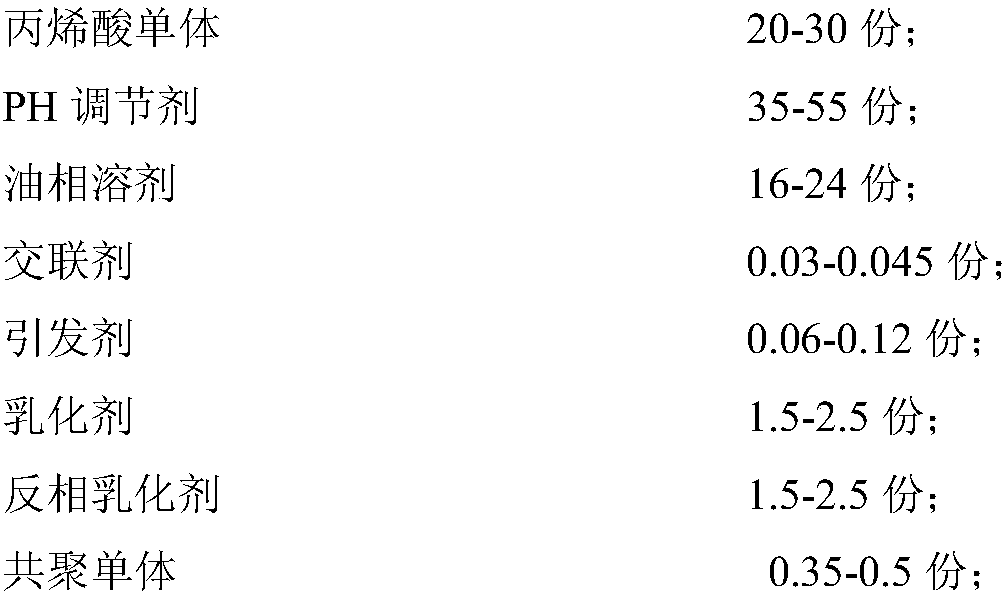An Electrolyte Resistant Pigment Printing Thickener
An electrolyte-resistant and paint-printing technology, applied in the field of paint-printing thickeners, can solve problems such as poor coordination between electrolyte-resistant ability and thickening effect, and achieve the effects of improving product storage stability, stable and gentle reaction, and reducing use costs.
- Summary
- Abstract
- Description
- Claims
- Application Information
AI Technical Summary
Problems solved by technology
Method used
Image
Examples
Embodiment 1
[0033] An electrolyte-resistant pigment printing thickener, by weight, comprising the following components:
[0034] Acrylic acid monomer 20 parts;
[0035] 35.5 parts of pH regulator;
[0036] 16 parts of oil phase solvent;
[0037] 0.03 parts of crosslinking agent;
[0038] 0.08 parts of initiator;
[0039] 1.6 parts of emulsifier;
[0040] 1.6 parts of inverse emulsifier;
[0041] 0.42 parts of comonomer;
[0042] Its preparation method comprises the following steps:
[0043] (1) Under the condition of stirring, slowly add the pH regulator dropwise to neutralize the acrylic acid monomer, and keep stirring so that the neutralization temperature does not exceed 40°C.
[0044] (2) Add initiator ammonium persulfate and a crosslinking agent to the neutralized solution in step (1) to obtain an aqueous phase.
[0045] (3) Mix the oil phase solvent, emulsifier and comonomer, and stir at high speed to obtain the oil phase.
[0046] (4) Mix the water phase obtained in step (...
Embodiment 2
[0049] An electrolyte-resistant pigment printing thickener, by weight, comprising the following components:
[0050] Acrylic acid monomer 25 parts;
[0051] 44.3 parts of pH regulator;
[0052] 20 parts of oil phase solvent;
[0053] 0.038 parts of crosslinking agent;
[0054] Initiator 0.01 part;
[0055] 2.0 parts of emulsifier;
[0056] 2.0 parts of inverse emulsifier;
[0057] 0.42 parts of comonomer;
[0058] Its preparation method comprises the following steps:
[0059] (1) Under the condition of stirring, slowly add the pH regulator dropwise to neutralize the acrylic acid monomer, and keep stirring so that the neutralization temperature does not exceed 40°C.
[0060] (2) Add initiator ammonium persulfate and a crosslinking agent to the neutralized solution in step (1) to obtain an aqueous phase.
[0061] (3) Mix the oil phase solvent, emulsifier and comonomer, and stir at high speed to obtain the oil phase.
[0062] (4) Mix the water phase obtained in step (2) ...
Embodiment 3
[0065] An electrolyte-resistant pigment printing thickener, by weight, comprising the following components:
[0066] Acrylic acid monomer 30 parts;
[0067] 53.3 parts of pH regulator;
[0068] 24 parts of oil phase solvent;
[0069] 0.045 parts of crosslinking agent;
[0070] 0.12 parts of initiator;
[0071] 2.4 parts of emulsifier;
[0072] 2.4 parts of inverse emulsifier;
[0073] 0.48 parts of comonomer;
[0074] Its preparation method comprises the following steps:
[0075] (1) Under the condition of stirring, slowly add the pH regulator dropwise to neutralize the acrylic acid monomer, and keep stirring so that the neutralization temperature does not exceed 40°C.
[0076] (2) Add initiator ammonium persulfate and a crosslinking agent to the neutralized solution in step (1) to obtain an aqueous phase.
[0077] (3) Mix the oil phase solvent, emulsifier and comonomer, and stir at high speed to obtain the oil phase.
[0078] (4) Mix the water phase obtained in step (2...
PUM
| Property | Measurement | Unit |
|---|---|---|
| viscosity | aaaaa | aaaaa |
Abstract
Description
Claims
Application Information
 Login to View More
Login to View More - R&D
- Intellectual Property
- Life Sciences
- Materials
- Tech Scout
- Unparalleled Data Quality
- Higher Quality Content
- 60% Fewer Hallucinations
Browse by: Latest US Patents, China's latest patents, Technical Efficacy Thesaurus, Application Domain, Technology Topic, Popular Technical Reports.
© 2025 PatSnap. All rights reserved.Legal|Privacy policy|Modern Slavery Act Transparency Statement|Sitemap|About US| Contact US: help@patsnap.com



